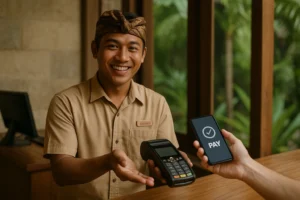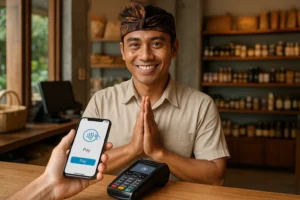Warning: 5 Shocking Mobile Payment Mistakes That Could Wreck Your Bali Trip (Don’t Be One of Them!)
Mobile payment has dramatically transformed Bali, the vibrant Island of the Gods, moving it swiftly from a cash-dominated economy to a digital-first landscape. From bustling Seminyak eateries to serene Ubud markets, mobile payment is now the preferred way to transact. This shift offers unparalleled convenience, security, and often, better exchange rates for savvy travelers. Yet, like any rapidly evolving technology, navigating mobile payment in Bali presents potential pitfalls. While the ease of tapping your phone for a refreshing coconut or a stunning batik dress is undeniable, a few missteps could turn your dream vacation into a frustrating ordeal.
This comprehensive guide delves into the five most common mobile payment mistakes travelers make in Bali. By understanding these blunders and how to avoid them, you can ensure your trip remains seamless, secure, and truly unforgettable. Don’t let a simple digital transaction overshadow the magic of Bali!
The Rapid Rise of Mobile Payment in Bali: A Digital Transformation
Just a few years ago, the idea of a fully cashless Bali seemed like a distant dream. ATMs were frequently visited, and pockets jingled with rupiah. Fast forward to mid-2025, and the landscape has dramatically shifted. The Indonesian government, through initiatives like QRIS (Quick Response Code Indonesian Standard), has aggressively promoted mobile payment adoption. This unified QR code system allows users of various payment apps to transact seamlessly with any merchant displaying the QRIS logo. You can learn more about QRIS and its impact on the Indonesian economy on Bank Indonesia’s official website.
This push has been met with enthusiasm from both locals and tourists. For businesses, it means faster transactions, reduced cash handling, and broader customer reach. For visitors, it’s about convenience, enhanced security (no more carrying large sums of cash), and often, better tracking of expenses. Major international mobile payment platforms, alongside popular local ones, are now widely accepted, making digital transactions almost as common as the Balinese smile.
However, familiarity with your home country’s mobile payment systems doesn’t automatically translate to a flawless experience in Bali. The nuances, security considerations, and connectivity challenges can trip up even the most tech-savvy traveler. Let’s explore the critical mistakes to avoid.

Mistake #1: Underestimating the Need for Local Mobile Payment Apps
One of the biggest blunders tourists make is assuming their preferred international mobile payment app will be universally accepted across Bali. While platforms like Apple Pay or Google Pay are gaining traction, especially in larger establishments, they might not be the default or even available in smaller warungs (local eateries), traditional markets, or independent shops.
Understanding QRIS and Local Apps: The key to widespread mobile payment acceptance in Bali is QRIS. Many local businesses, particularly those outside major tourist hubs, primarily rely on QRIS for digital transactions. While some international apps might be able to scan QRIS codes, having a dedicated local app provides a more robust and reliable experience.
Popular Indonesian mobile payment apps include:
- Gojek/GoPay: Gojek started as a ride-hailing service but has evolved into a super-app. GoPay is their integrated digital wallet, widely accepted for everything from food delivery to retail purchases and even paying for massages. It’s incredibly convenient and almost universally recognized. You can find out more about Gojek’s services on their official website.
- OVO: Another dominant player, OVO is frequently used for retail payments, ride-hailing (Grab), and various online transactions. Many loyalty programs and discounts are tied to OVO payments.
- DANA: A standalone digital wallet, DANA offers a wide range of payment services and is increasingly popular for everyday transactions.
The Solution: Before your trip, or shortly after arriving, consider downloading and setting up at least one popular local mobile payment app, like GoPay or OVO. While setting up these apps might require a local SIM card and sometimes a local bank account for full functionality, many offer basic visitor-friendly options for loading funds (e.g., via international credit card or top-up at minimarts). Having one of these apps significantly expands your mobile payment acceptance options, ensuring you’re never caught off guard. Remember, the convenience of a local app often outweighs the slight initial setup effort.
Mistake #2: Neglecting Your Device’s Security for Mobile Payments
Your smartphone is now your wallet, and potentially, your entire financial life in Bali. Neglecting its security, especially when engaging in mobile payment transactions, is a catastrophic mistake that could lead to significant financial loss and personal data compromise.
The Risks: Public Wi-Fi networks, while convenient, are often unsecured and ripe for malicious activity. Phishing attempts targeting your mobile payment credentials are also prevalent. Losing your phone, or having it stolen, without proper security measures, could grant unauthorized access to your funds and sensitive information. For general tips on securing your mobile device, you can refer to resources from cybersecurity organizations.
Protecting Your Digital Wallet:
- Strong Passcodes/Biometrics: Always use a strong, unique passcode, PIN, or biometric authentication (fingerprint, facial recognition) to unlock your phone. Do not rely solely on a simple swipe or pattern.
- App-Specific Security: Ensure your mobile payment apps themselves require a separate PIN or biometric verification for every transaction or upon opening. This adds an extra layer of defense even if your phone is unlocked.
- Avoid Public Wi-Fi for Sensitive Transactions: When making mobile payment transactions or accessing banking apps, avoid using unsecured public Wi-Fi networks. Opt for your mobile data or a trusted personal hotspot.
- Beware of Phishing and Scams: Be incredibly wary of unsolicited messages or emails asking for your mobile payment login details or PIN. Legitimate companies will never ask for this information via email or text. Always verify the source.
- Enable Remote Wipe/Lock: Set up your phone’s “find my device” feature (e.g., Apple’s Find My, Google’s Find My Device). This allows you to remotely locate, lock, or wipe your phone if it’s lost or stolen, protecting your mobile payment accounts.
Your proactive security measures are the best defense against digital theft. Treat your phone as you would your physical wallet, with even greater care given its digital contents.
Mistake #3: Forgetting About Connectivity Issues and Data Roaming Costs
Mobile payment relies entirely on an internet connection. Assuming seamless connectivity everywhere in Bali, or neglecting the costs of international data roaming, can leave you stranded without a way to pay.
Connectivity Challenges: While Bali’s major tourist areas boast decent mobile coverage, venturing into more remote regions, or even certain spots within busy towns, can lead to patchy or non-existent internet signals. Imagine trying to pay for a taxi in a rural area after a beautiful temple visit, only to find your mobile payment app won’t connect.
The High Cost of Roaming: Relying on your home country’s data roaming plan can quickly rack up exorbitant charges. A few minutes of transactions and app usage could lead to a bill shock that far outweighs any convenience.
Smart Connectivity Solutions for Mobile Payment:
- Local SIM Card: This is by far the most cost-effective and reliable solution. Purchase a local Indonesian SIM card upon arrival (Telkomsel, XL Axiata, Indosat Ooredoo are major providers). Data packages are incredibly affordable, ensuring you always have a reliable connection for your mobile payment needs. You can often find kiosks selling SIM cards directly at Bali’s Ngurah Rai International Airport.
- Portable Wi-Fi Device (Mifi): If you’re traveling with multiple devices or a group, a portable Wi-Fi device can be an excellent investment, providing a secure and consistent internet connection wherever you go.
- Offline Mode (If Available): Check if any of your chosen mobile payment apps offer an offline mode for certain transactions (though this is rare for primary payment functions, some may allow pre-loading for specific vendors).
- Always Have a Backup: Even with a local SIM, never rely solely on mobile payment. Always carry a small amount of local currency (Indonesian Rupiah – IDR) for emergencies or places that are cash-only. A credit or debit card is also a wise backup.
Ensure your mobile payment strategy accounts for potential connectivity gaps. A local SIM card is your best friend in this scenario.
Mistake #4: Not Checking Exchange Rates and Transaction Fees for Mobile Payment
While mobile payment can offer convenience, blindly tapping and paying without understanding exchange rates and potential transaction fees can lead to you spending more than you realize.
Dynamic Currency Conversion (DCC): This is a common trap. When paying with an international card or a mobile payment app linked to an international card, merchants might offer to charge you in your home currency. While it seems helpful, the exchange rate used is almost always less favorable than your bank’s rate, and the merchant (or their payment processor) pockets the difference. Reputable financial advice websites often warn against DCC.
Foreign Transaction Fees: Many credit cards and some mobile payment platforms charge foreign transaction fees (typically 1-3%) for purchases made in a foreign currency. These fees can add up quickly over a trip.
Tips for Smart Mobile Payment Spending:
- Always Choose Local Currency (IDR): When prompted, always opt to be charged in Indonesian Rupiah (IDR). Let your bank or mobile payment provider handle the currency conversion, as their rates are almost always better.
- Understand Your Card/App’s Fees: Before you travel, contact your bank or check your mobile payment app’s terms and conditions regarding foreign transaction fees. Consider using a travel-specific credit card that waives these fees.
- Monitor Your Transactions: Regularly check your mobile payment app’s transaction history and your bank statements. This helps you spot any suspicious activity, unauthorized charges, or discrepancies in exchange rates. Many apps offer real-time notifications for transactions, which is incredibly useful.
- Consider Multi-Currency Wallets: Some mobile payment services or travel cards offer multi-currency wallets that allow you to hold and spend IDR at a favorable rate, minimizing conversion fees.
Being vigilant about exchange rates and fees ensures that the convenience of mobile payment doesn’t come at an inflated cost.
Mistake #5: Over-Reliance on Mobile Payment and Forgetting Cash/Card Backups
The convenience of mobile payment can be intoxicating, leading some travelers to completely abandon traditional payment methods. This over-reliance is a critical mistake in Bali, where a truly cashless society is still a work in progress.
Why You Still Need Backups:
- Smaller Vendors: Many small vendors, street food stalls, and local markets (especially outside prime tourist areas) remain cash-only. They might not have the technology or the volume of transactions to justify mobile payment systems.
- Technical Glitches: Even in technologically advanced countries, point-of-sale systems can fail, internet connections drop, or mobile payment apps experience temporary glitches. Having a backup prevents embarrassment and inconvenience.
- Power Outages: Bali, while developed, can still experience occasional power outages, rendering electronic payment terminals and sometimes even mobile data towers inoperable.
- Lost/Stolen Phone: If your phone is lost, stolen, or damaged, your primary mobile payment method is instantly gone.
The Smart Traveler’s Approach:
- Carry Some Local Currency (IDR): Always have a decent amount of Indonesian Rupiah on hand for small purchases, tips, or emergencies. This doesn’t mean carrying huge sums, but enough for a few meals, drinks, or souvenir purchases.
- Credit/Debit Card as Backup: Bring at least one international credit or debit card. Ensure your bank knows you’re traveling to Bali to prevent fraud alerts from blocking your card. You can find general travel advisories on payment methods from sources like official government travel sites.
- Separate Your Funds: Don’t keep all your money in one place. Distribute cash, cards, and your mobile payment access across different locations (e.g., some cash in your wallet, some in a money belt, a card in your day bag, another in your luggage).
- Understand ATM Fees: If you need to withdraw cash, be aware of potential ATM fees from both the local bank and your home bank.
While mobile payment is a fantastic tool in Bali, it’s a complement, not a complete replacement, for a well-rounded payment strategy. A balanced approach ensures you’re prepared for any situation.

Embrace the Digital Wave, But Stay Smart!
Bali’s embrace of mobile payment is a testament to its dynamic spirit and forward-thinking approach. It offers an incredible level of convenience and security, transforming the travel experience for millions. By understanding the common pitfalls – from overlooking local app necessities and neglecting device security, to grappling with connectivity issues, hidden fees, and over-reliance – you can confidently navigate Bali’s evolving digital landscape.
Your Balinese adventure should be filled with breathtaking sunsets, delicious food, and cultural immersion, not payment woes. Arm yourself with the right knowledge and a smart approach to mobile payment, and you’re set for an unforgettable journey.
Planning your ultimate Bali escape? While you’re here, why not explore some of the stunning real estate opportunities on the island? Whether you’re dreaming of a luxury villa or a charming traditional home, our properties offer the perfect blend of modern comfort and Balinese serenity. Discover your dream property today and secure your slice of paradise. Visit Pure Land to see our current listings. Or, if you have any questions, feel free to reach out to us directly at here. And for more insights into living and traveling in Bali, make sure to read our other blog posts.
